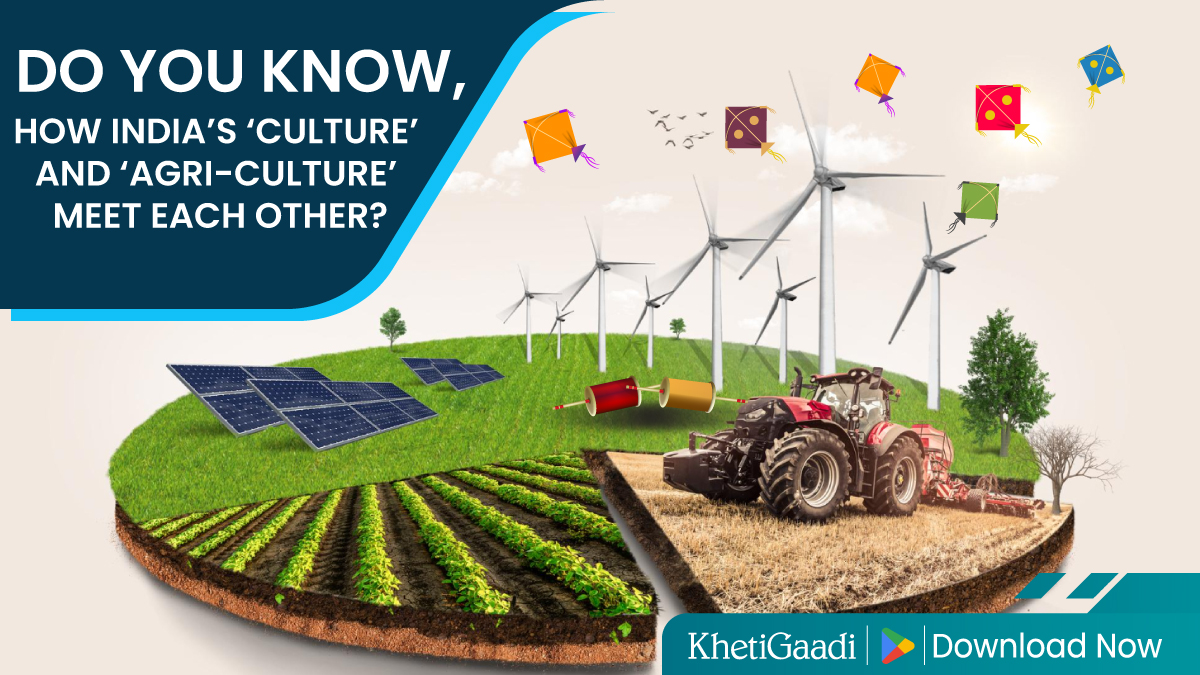Makar Sankranti is one of the biggest festivals of the country of India where people see it as a festival of gratitude, harvest as well as new beginnings. The festival is celebrated every year on January 14th and is celebrated on the day of the transition of the sun into zodiac sign Capricorn (‘Makar’) marking the end of the winter solstice. But for the farmers, this is not a day of celebration, but culmination of the long months of toil and work, and an occasion of rejoicing in this toil and in its fruits.
KhetiGaadi always provides right tractor information
Importance of Makar Sankranti to Farmers
India is an agrarian economy; farmers are the backbone of the nation’s economy and food security. But their hard work sees to it that the nation’s plates are fed, in conditions such as uncertain weather, varying market prices and literal toil. Makar Sankranti is the event of the completion of Rabi crop harvest, one of many important times of 12 months the place fields are so literally bursting with golden grains ready for gathering. It’s a moment of triumph for farmers, the result of a lot of hard work. “Uttarayan” also happens to coincide with the beginning of sun’s northward journey — Uttarayana — that traditionally translates to longer days and warmer weather. This is an important transition that determines the agricultural cycle, a season when farmers start preparing their farm to sow the Kharif crops to come. So, Makar Sankranti is a festival of past efforts and the flavour of the coming wealth.
The Hard Work of Farmers
Without them, these food miles would be impossible to cover: the farmers, like unsung heroes of Indian society who toil from dawn to dusk to grow the food that feeds millions. They work so closely with nature that they have to be able to withstand droughts floods and pests. Often they give up their comfort for what’s best for the nation.
Makar Sankranti is a festival that salutes this hard work. This is a time when we together pay homage to them, for they are important link in the cultural and economic fabric of the country and for a country like us are essential and making ecology part of agriculture is very important. And besides being personal victories, they are celebrations of this very community, a community that bonds so easily because it is formed by our work.
The Cultural Significance of Makar Sankranti
Makar Sankranti is much more than a harvest festival; it’s a deeply spiritual event. It stands for positive, new beginning, and good fortune. The festival is celebrated in different ways across India, with a different custom that reflect regional traditions and people’s ways to pay tribute to the sun, the earth and the labours of farmers.
It is the festival of legends in Hindu mythology. The second most common belief is that on this day the father of this world, Lord Surya visits his son, Shani, symbolizing togetherness, forgiveness and disposing the malign interventions of ‘Shani’ into our lives. It is said that celestial movements are aligned very auspicious and it is good time for new ventures, prayers and charity.
How is Makar Sankranti celebrated by Farmers?
The festival of Makar Sankranti is a day when farmers say thank you, share their wealth. The celebrations are marked by joy, community gatherings, and rituals:
- Thanksgiving to Nature: Man prays to the Sun God and Mother Earth to be thanked for a bountiful harvest.
- Community Bonding: They get villages alive with the vibrancy of their festive. Farmers and their families gather as unified community to celebrate together and strengthen those bonds. A celebration is performed, with folk songs and dances reflected, as they link to the cultural heritage of agriculture.
- Sharing the Harvest: Farmers were a time of generosity. Farmers shared their produce with friends, neighbours and the less fortunate. This sharing act extends the socially connectedness.
- Kite Flying and Bonfires: It is really symbolic freedom and hope gesture, especially in states like Gujarat and Rajasthan. Lohri— Maka Sankranti— is a precursor to bonfires that families lit in Punjab to celebrate the New Year, where families come together to sing, dance and celebrate the season’s blessings.
Makar Sankranti Regional Variations India’s cultural diversity is beautifully reflected in the different ways Makar Sankranti is celebrated across states:
1) Pongal in Tamil Nadu: The four days of Pongal starts when we ‘cleans out’ all old things in the first day – Bhogi. Traditional Pongal dish of rice, milk and jaggery is cooked as an offering to the Sun God by the farmers.
2) Lohri in Punjab and Haryana: Lohri is celebrated with bonfire, Bhangra folk dances and distribution of gur (jaggery) and rewri (sesame candy). It is also marking cane and wheat harvesting.
3) Sankranthi in Andhra Pradesh and Telangana: The festival is observed for three days and rituals like Bhogi Mantalu (sacred Bonfires) and Gobbemal (worshipping Cow Dung Idols).
4) Magh Bihu in Assam: The community fish in Assam and feast on the traditional Assamese delicacies and make makeshift huts (Meji) to burn as a tribute for the gods.
5) Uttarayan in Gujarat: It also thrives in kite flying with colours kites filling the sky, making a happy atmosphere.
Special Foods and Rituals Makar Sankranti is a celebration involving food, each region has its own food delicacy.
Commonly prepared dishes include:
- Til-Gur Laddoos: These are sweet made of jaggery just by sesame seeds. These sweet symbolizes togetherness and warmth associated with their smell. Pongal: This is a sweet and savoury rice dish of South India.
- Chikkis: Jaggery and peanuts or sesame seeds based crunchy snacks. There is also a bunch of rituals such as taking holy dips in river (Ganga, Yamuna, Godavari, etc.), donating clothes, food, money which are believed to bring blessings and prosperity.
Government Initiatives to the Farmers on Makar Sankranti
Recognizing the importance of farmers and their contribution to the nation’s economy, the government has introduced several schemes and initiatives this year:
- Enhanced Support Prices: For better income security of the farmers, the minimum support price (MSP) for the staples has been increased.
- PM-KUSUM Solar Scheme: This initiative is providing farmers with solar powered pumps to promote sustainable irrigation practices reducing the need for expensive electrical power.
- Crop Insurance Benefits: In order to protect them from the loss caused by unexpected calamities, farmers have been provided with a new revamped crop insurance scheme with lower premiums and a faster claim payouts.
- Agri-Infrastructure Development: To reduce post harvest losses, new warehouses and cold storage facilities are being set up to give farmers a better price for their produce.
- Soil Health Campaigns: To enable better yield and profitability, free soil testing campaigns are being done to educate farmers of the ideal crop and fertilisation techniques they can choose from.
Stay connected to the KhetiGaadi WhatsApp channel and get the latest updates on farming innovations and government schemes. Visit KhetiGaadi for more information and guidance.
Contact Khetigaadi for guidance and updates on agriculture schemes for farmers:
Phone: 07875114466
To know more about tractor price contact to our executive






